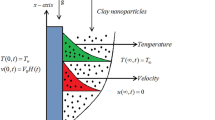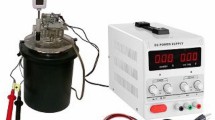Abstract
Drilling fluids are significant in the drilling methods of oils and gases from rocks and land. To improve the performance of drilling fluid clay nanoparticles, play a vital rule. When clay nanoparticles are added to the drilling fluids, the thermal conductivity, viscosity levels, and boiling point of the fluid boost which provide resistant to high temperatures and control the fluid cost. Bearing in mind the substantial rule of clay nanoparticles in drilling fluid, this article demonstrates the convection heat transfer in drilling nanofluid. More exactly, clay nanoparticles are suspended in three different based fluids (water, kerosene, and engine oil). The mathematical expressions of Maxwell–Garnett and Brinkman for the effective thermophysical properties of clay nanofluids are utilized, whereas the flow phenomenon is governed by a set linear PDEs with physical initial and boundary conditions. The Laplace transform technique is applied to obtain exact analytical solutions for velocity and temperature profiles. The skin friction and Nusselt number are computed and presented in tabular forms. To insight the influence of various flow parameters, the obtained solutions are computed using Mathcad and plotted in different figures. The results show that the Nusselt number is significantly increased with increasing values of volume concentration.







Similar content being viewed by others
References
Saqib, M., et al.. (2018) Entropy generation in different types of fractionalized Nanofluids. Arabian Journal for Science and Engineering, p. 1–10.
Choi, S. U. S. (1995). “. Enhancing thermal conductivity of fluids with nanoparticles,”" developments and applications of non-Newtonian flows". ASME, New York, 231, 99–105.
Ahmed, N., et al.. (2018) Transient MHD convective flow of fractional nanofluid between vertical plates. Journal of Applied and Computational Mechanics.
Rahimi-Gorji, M., et al. (2017). Modeling of the air conditions effects on the power and fuel consumption of the SI engine using neural networks and regression. Journal of the Brazilian Society of Mechanical Sciences and Engineering, 39(2), 375–384.
Rahimi-Gorji, M., et al. (2015). CFD simulation of airflow behavior and particle transport and deposition in different breathing conditions through the realistic model of human airways. Journal of Molecular Liquids, 209, 121–133.
Saqib, M., Khan, I., & Shafie, S. (2018). Application of Atangana–Baleanu fractional derivative to MHD channel flow of CMC-based-CNT's nanofluid through a porous medium. Chaos, Solitons & Fractals, 116, 79–85.
Khanafer, K., Vafai, K., & Lightstone, M. (2003). Buoyancy-driven heat transfer enhancement in a two-dimensional enclosure utilizing nanofluids. International Journal of Heat and Mass Transfer, 46(19), 3639–3653.
Buongiorno, J. (2006). Convective transport in nanofluids. Journal of Heat Transfer, 128(3), 240–250.
Tiwari, R. K., & Das, M. K. (2007). Heat transfer augmentation in a two-sided lid-driven differentially heated square cavity utilizing nanofluids. International Journal of Heat and Mass Transfer, 50(9–10), 2002–2018.
Ahmad, S., & Pop, I. (2010). Mixed convection boundary layer flow from a vertical flat plate embedded in a porous medium filled with nanofluids. International Communications in Heat and Mass Transfer, 37(8), 987–991.
Biglarian, M., et al. (2017). H2O based different nanofluids with unsteady condition and an external magnetic field on permeable channel heat transfer. International Journal of Hydrogen Energy, 42(34), 22005–22014.
Mosayebidorcheh, S., et al. (2017). Transient thermal behavior of radial fins of rectangular, triangular and hyperbolic profiles with temperature-dependent properties using DTM-FDM. Journal of Central South University, 24(3), 675–682.
Pourmehran, O., et al. (2015). Comparison between the volumetric flow rate and pressure distribution for different kinds of sliding thrust bearing. Propulsion and Power Research, 4(2), 84–90.
Pourmehran, O., et al. (2015). Simulation of magnetic drug targeting through tracheobronchial airways in the presence of an external non-uniform magnetic field using Lagrangian magnetic particle tracking. Journal of Magnetism and Magnetic Materials, 393, 380–393.
Pourmehran, O., et al.. (2018) Rheological behaviour of various metal-based nano-fluids between rotating discs: A new insight. Journal of the Taiwan Institute of Chemical Engineers.
Rahimi-Gorji, M., et al. (2016). Unsteady squeezing nanofluid simulation and investigation of its effect on important heat transfer parameters in presence of magnetic field. Journal of the Taiwan Institute of Chemical Engineers, 67, 467–475.
Saqib, M., et al.. (2018) Convection in ethylene glycol-based molybdenum disulfide nanofluid. Journal of Thermal Analysis and Calorimetry, p. 1–10.
Trisaksri, V., & Wongwises, S. (2007). Critical review of heat transfer characteristics of nanofluids. Renewable and Sustainable Energy Reviews, 11(3), 512–523.
Ali, F., et al. (2017). Exact analysis of MHD flow of a Walters'-B fluid over an isothermal oscillating plate embedded in a porous medium. The European Physical Journal Plus, 132(2), 95.
Khan, I., Saqib, M., & Ali, F. (2017). Application of time-fractional derivatives with non-singular kernel to the generalized convective flow of Casson fluid in a microchannel with constant walls temperature. The European Physical Journal Special Topics, 226(16–18), 3791–3802.
Khan, I., Saqib, M., & Ali, F. (2018). Application of the modern trend of fractional differentiation to the MHD flow of a generalized Casson fluid in a microchannel: Modelling and solution⋆. The European Physical Journal Plus, 133(7), 262.
Sheikh, N. A., et al. (2017). On the applications of nanofluids to enhance the performance of solar collectors: A comparative analysis of Atangana-Baleanu and Caputo-Fabrizio fractional models. The European Physical Journal Plus, 132(12), 540.
Öztop, H. F., et al. (2015). A brief review of natural convection in enclosures under localized heating with and without nanofluids. International Communications in Heat and Mass Transfer, 60, 37–44.
Hussanan, A., et al. (2017). Convection heat transfer in micropolar nanofluids with oxide nanoparticles in water, kerosene and engine oil. Journal of Molecular Liquids, 229, 482–488.
Tesfai, W., et al. (2013). Rheology and microstructure of dilute graphene oxide suspension. Journal of Nanoparticle Research, 15(10), 1989.
Wu, J. M., & Zhao, J. (2013). A review of nanofluid heat transfer and critical heat flux enhancement—Research gap to engineering application. Progress in Nuclear Energy, 66, 13–24.
Khan, I. (2017). Shape effects of MoS2 nanoparticles on MHD slip flow of molybdenum disulphide nanofluid in a porous medium. Journal of Molecular Liquids, 233, 442–451.
Sheikholeslami, M., & Bhatti, M. M. (2017). Active method for nanofluid heat transfer enhancement by means of EHD. International Journal of Heat and Mass Transfer, 109, 115–122.
Abdelsalam, S.I. and M.M. Bhatti. (2018) The impact of impinging TiO2 nanoparticles in Prandtl nanofluid along with endoscopic and variable magnetic field effects on peristaltic blood flow. Multidiscipline Modeling in Materials and Structures.
Abdelsalam, S. I., & Bhatti, M. M. (2018). The study of non-Newtonian nanofluid with hall and ion slip effects on peristaltically induced motion in a non-uniform channel. RSC Advances, 8(15), 7904–7915.
Brinkman, H. C. (1952). The viscosity of concentrated suspensions and solutions. The Journal of Chemical Physics, 20(4), 571–571.
Aminossadati, S. M., & Ghasemi, B. (2009). Natural convection cooling of a localised heat source at the bottom of a nanofluid-filled enclosure. European Journal of Mechanics - B/Fluids, 28(5), 630–640.
Matin, M. H., & Pop, I. (2013). Forced convection heat and mass transfer flow of a nanofluid through a porous channel with a first order chemical reaction on the wall. International Communications in Heat and Mass Transfer, 46, 134–141.
Author information
Authors and Affiliations
Corresponding author
Additional information
Publisher’s Note
Springer Nature remains neutral with regard to jurisdictional claims in published maps and institutional affiliations.
Rights and permissions
About this article
Cite this article
Khan, I., Hussanan, A., Saqib, M. et al. Convective Heat Transfer in Drilling Nanofluid with Clay Nanoparticles: Applications in Water Cleaning Process. BioNanoSci. 9, 453–460 (2019). https://doi.org/10.1007/s12668-019-00623-1
Published:
Issue Date:
DOI: https://doi.org/10.1007/s12668-019-00623-1




